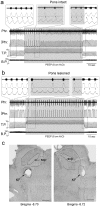Nonassociative learning promotes respiratory entrainment to mechanical ventilation
- PMID: 17848996
- PMCID: PMC1959120
- DOI: 10.1371/journal.pone.0000865
Nonassociative learning promotes respiratory entrainment to mechanical ventilation
Abstract
Background: Patient-ventilator synchrony is a major concern in critical care and is influenced by phasic lung-volume feedback control of the respiratory rhythm. Routine clinical application of positive end-expiratory pressure (PEEP) introduces a tonic input which, if unopposed, might disrupt respiratory-ventilator entrainment through sustained activation of the vagally-mediated Hering-Breuer reflex. We suggest that this potential adverse effect may be averted by two differentiator forms of nonassociative learning (habituation and desensitization) of the Hering-Breuer reflex via pontomedullary pathways.
Methodology/principal findings: We tested these hypotheses in 17 urethane-anesthetized adult Sprague-Dawley rats under controlled mechanical ventilation. Without PEEP, phrenic discharge was entrained 1:1 to the ventilator rhythm. Application of PEEP momentarily dampened the entrainment to higher ratios but this effect was gradually adapted by nonassociative learning. Bilateral electrolytic lesions of the pneumotaxic center weakened the adaptation to PEEP, whereas sustained stimulation of the pneumotaxic center weakened the entrainment independent of PEEP. In all cases, entrainment was abolished after vagotomy.
Conclusions/significance: Our results demonstrate an important functional role for pneumotaxic desensitization and extra-pontine habituation of the Hering-Breuer reflex elicited by lung inflation: acting as buffers or high-pass filters against tonic vagal volume input, these differentiator forms of nonassociative learning help to restore respiratory-ventilator entrainment in the face of PEEP. Such central sites-specific habituation and desensitization of the Hering-Breuer reflex provide a useful experimental model of nonassociative learning in mammals that is of particular significance in understanding respiratory rhythmogenesis and coupled-oscillator entrainment mechanisms, and in the clinical management of mechanical ventilation in respiratory failure.
Conflict of interest statement
Figures




References
-
- Tobin MJ, Alex C, Fahey PJ. Fighting the ventilator. In: Tobin MJ, editor. Principles and Practice of Mechanical Ventilation. 2 ed. New York: McGraw-Hill; 2006. pp. 1121–1136.
-
- Dick CR, Sassoon CS. Patient-ventilator interactions. Clin Chest Med. 1996;17:423–438. - PubMed
-
- Kondili E, Prinianakis G, Georgopoulos D. Patient-ventilator interaction. Br J Anaesth. 2003;91:106–119. - PubMed
-
- Tobin MJ, Jubran A, Laghi F. Patient-ventilator interaction. Am J Respir Crit Care Med. 2001;163:1059–1063. - PubMed
-
- Tobin MJ. Advances in mechanical ventilation. N Engl J Med. 2001;344:1986–1996. - PubMed
Publication types
MeSH terms
Grants and funding
LinkOut - more resources
Full Text Sources
Other Literature Sources
Medical

